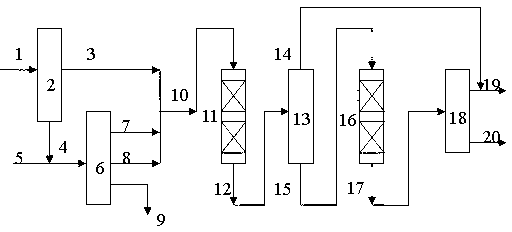Method for producing light fuel oil from ethylene tar
A light fuel oil and ethylene tar technology, applied in the field of combined process of delayed coking and hydrogenation, can solve the problem of poor quality of liquid products - coker gasoline, diesel oil and wax oil, liquid yield and light fuel oil product yield Low efficiency, ethylene tar fraction has not been effectively treated, etc., to achieve the effects of long-term operation, ease of feeding difficulties, and reduction of olefin content
- Summary
- Abstract
- Description
- Claims
- Application Information
AI Technical Summary
Problems solved by technology
Method used
Image
Examples
Embodiment 1~3
[0044] use figure 1 process. Ethylene tar was distilled into light fraction and heavy fraction, with 420°C and 480°C as the cut-off points, respectively, to obtain light fraction and heavy fraction after distillation. The properties of the vacuum residue are listed in Table 2. Table 3. The obtained ethylene tar heavy fraction was mixed with the vacuum residue, the mixed raw material and its delayed coking process conditions, and the properties of the obtained gasoline and diesel fractions are shown in Table 4. Coker gasoline, coker diesel oil and ethylene tar light fraction are mixed together as the raw material for the hydrofinishing reactor. The reactor is filled with hydrogenation protecting agent FZC-103 and hydrofinishing catalyst 3936 from top to bottom. The volume ratio of the two catalysts is 1:4, the hydrofining reaction process conditions and the properties of the resulting fraction heavier than gasoline are shown in Table 5. In this example, a distillate heavier t...
PUM
| Property | Measurement | Unit |
|---|---|---|
| specific surface area | aaaaa | aaaaa |
| specific surface area | aaaaa | aaaaa |
| diameter | aaaaa | aaaaa |
Abstract
Description
Claims
Application Information
 Login to View More
Login to View More - R&D
- Intellectual Property
- Life Sciences
- Materials
- Tech Scout
- Unparalleled Data Quality
- Higher Quality Content
- 60% Fewer Hallucinations
Browse by: Latest US Patents, China's latest patents, Technical Efficacy Thesaurus, Application Domain, Technology Topic, Popular Technical Reports.
© 2025 PatSnap. All rights reserved.Legal|Privacy policy|Modern Slavery Act Transparency Statement|Sitemap|About US| Contact US: help@patsnap.com

